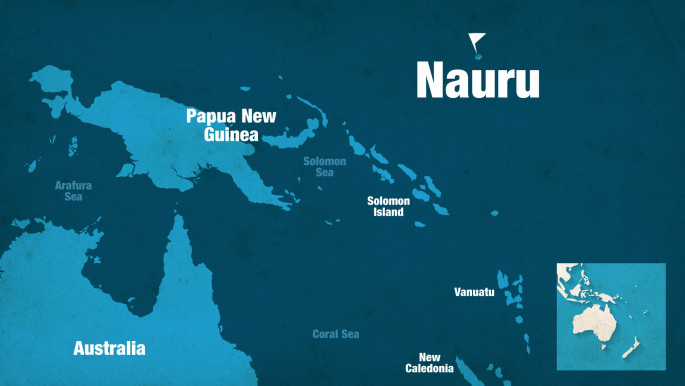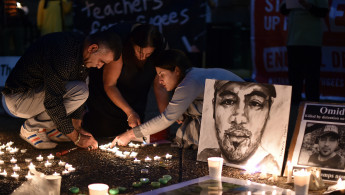The Nauru Files: Torture on Australia’s doorstep
The Nauru Files: Torture on Australia’s doorstep
Leaked documents have revealed more than 2,000 incidents of abuse and harassment at the Australian run detention facility on Nauru Island, with many incidents involving children.
3 min read
Iranian refugee, Omid Masoumali, set himself on fire in protest to the island's conditions [Getty]
Thousands of incidents of abuse and harassment have been uncovered on the Australian run detention facility on Nauru Island.
The leaked documents, published by the Guardian Australia, show more than 2,000 incidents occur in the period between August 2013 and October 2015.
Reports about the incidents were written by guards, caseworkers and teachers on the remote island, and included sexual assault, assault, child abuse, hunger strikes, self-harm and threatened self-harm.
There are currently 442 people held on Nauru, where the majority are men.
But despite making up only 20 percent of the population, over half the incidents involved children.
There were seven reports of sexual assault against the centre’s 49 child detainees, and 59 reports of assault. The abuse against the children is said to be perpetrated by guards, and some other reports by unknown men. There were also 30 incidents of self-harm by children.
Canberra has privatised its immigration detention system like many other countries, but has gone one step further and exported its detention centres offshore.
Australia’s strict immigration policy sees asylum seekers who arrive by boat intercepted and sent to detention facilities on Nauru, or Manus Island in Papa New Guinea, where they are told they will never be resettled in Australia.
Their controversial policy is part of the deterrent strategy established to "stop the boats" arriving to Australia in the first place.
This strict policy, that costs Australian taxpayers $1.2 billion a year, has been widely criticised by the United Nations and several human rights organisations.
The facilities, often referred to as gulags, have been shrouded in secrecy, many say in an effort to cover up the systematic abuse that has been a feature of the camps for years.
However, it is not the first time they have made headlines.
In April of this year, 23-year-old Iranian refugee, Omid Masoumali, set himself on fire in protest of conditions on the island. He died in hospital days later. A young Somali refugee also attempted the same fate but survived.
Over 20 staff members of Save the Children, who wrote a number of the incident reports, have spoken out in response to the leak.
"It appears from looking through the published database that nowhere near the full extent of the incident reports written on a day to day basis have been released" a spokesperson for the charity said, adding, "What you are seeing here is just the tip of the iceberg."
A statement from UNHCR stated that although they were not able to verify the individual incidents in the reports, the information was consistent with their longstanding concerns regarding the mental health and conditions of asylum seekers on Nauru.
In comparison with the worlds forced migration figures, the numbers arriving to Australia are miniscule. In 2015, Australia resettled a mere 9,399 refugees, 2171 fewer than in 2014. In comparison, Germany registered near to a million asylum seekers the same year.
The leaked documents, published by the Guardian Australia, show more than 2,000 incidents occur in the period between August 2013 and October 2015.
Reports about the incidents were written by guards, caseworkers and teachers on the remote island, and included sexual assault, assault, child abuse, hunger strikes, self-harm and threatened self-harm.
There are currently 442 people held on Nauru, where the majority are men.
But despite making up only 20 percent of the population, over half the incidents involved children.
There were seven reports of sexual assault against the centre’s 49 child detainees, and 59 reports of assault. The abuse against the children is said to be perpetrated by guards, and some other reports by unknown men. There were also 30 incidents of self-harm by children.
 |
Despite making up only 20 percent of the population, over half the incidents involved children |  |
 |
|
Australia’s strict immigration policy sees asylum seekers who arrive by boat intercepted and sent to detention facilities on Nauru, or Manus Island in Papa New Guinea, where they are told they will never be resettled in Australia.
Their controversial policy is part of the deterrent strategy established to "stop the boats" arriving to Australia in the first place.
This strict policy, that costs Australian taxpayers $1.2 billion a year, has been widely criticised by the United Nations and several human rights organisations.
 |
Australia’s strict immigration policy sees asylum seekers who arrive by boat intercepted and sent to detention facilities where they are told they will never be resettled in Australia |  |
However, it is not the first time they have made headlines.
In April of this year, 23-year-old Iranian refugee, Omid Masoumali, set himself on fire in protest of conditions on the island. He died in hospital days later. A young Somali refugee also attempted the same fate but survived.
Over 20 staff members of Save the Children, who wrote a number of the incident reports, have spoken out in response to the leak.
"It appears from looking through the published database that nowhere near the full extent of the incident reports written on a day to day basis have been released" a spokesperson for the charity said, adding, "What you are seeing here is just the tip of the iceberg."
A statement from UNHCR stated that although they were not able to verify the individual incidents in the reports, the information was consistent with their longstanding concerns regarding the mental health and conditions of asylum seekers on Nauru.
In comparison with the worlds forced migration figures, the numbers arriving to Australia are miniscule. In 2015, Australia resettled a mere 9,399 refugees, 2171 fewer than in 2014. In comparison, Germany registered near to a million asylum seekers the same year.


![President Pezeshkian has denounced Israel's attacks on Lebanon [Getty]](/sites/default/files/styles/image_684x385/public/2173482924.jpeg?h=a5f2f23a&itok=q3evVtko)



 Follow the Middle East's top stories in English at The New Arab on Google News
Follow the Middle East's top stories in English at The New Arab on Google News


